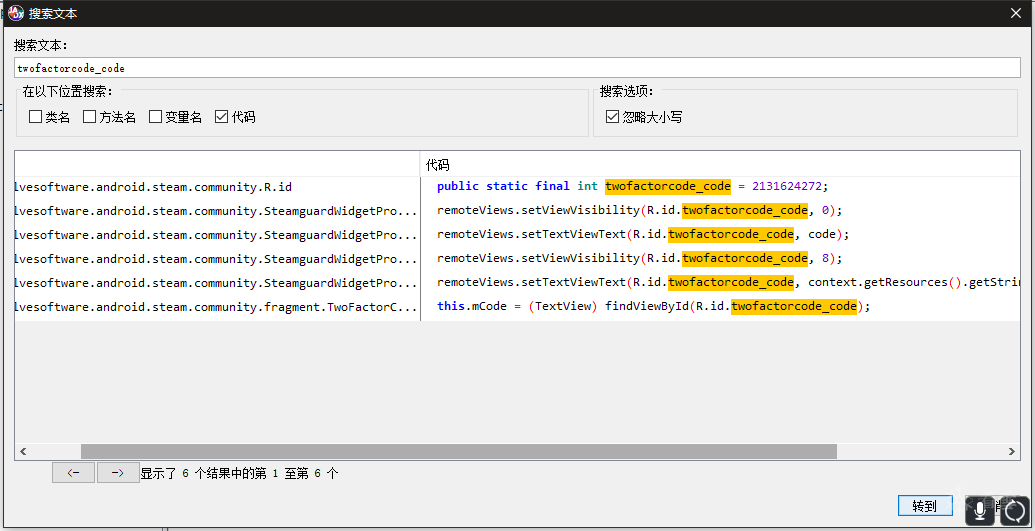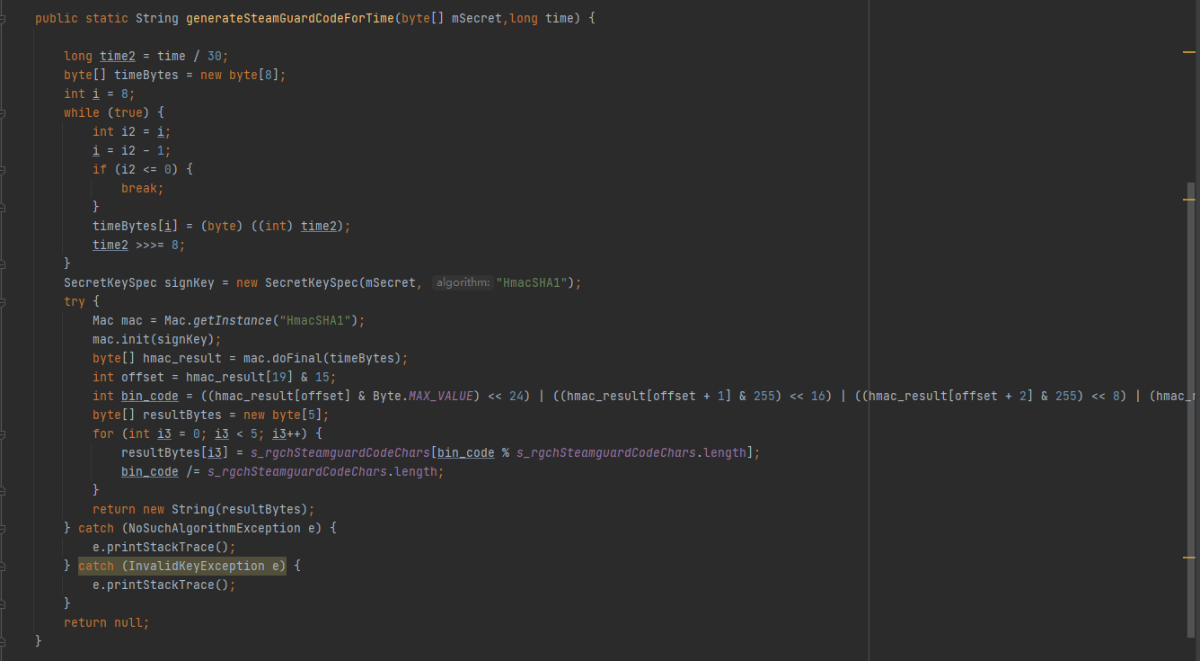最近有一个项目需要将steam的令牌算法取出放置在PC上对接接口执行,由于steam令牌只能在手机上查看,所以使用起来非常不方便。 但我也没想到steam的APK居然才4M,而且没做任何混淆啥的处理,对新手非常之友好!

由于steam令牌它是不需要联网计算的,所以得知肯定是本地算法生成,但它是如何做到与服务器同步? 那必然肯定是在我们登录steam添加令牌时服务器和APP已经协商好了加密的方式,数据等并且存放在手机缓存上了。
由于steam令牌弹出的界面,它显示的只有令牌码以及用户名,我们没办法直接通过搜索字符串的方式去定位,所以只能换个其它的方式去定位它的代码,而且发现界面大部分是webview组成的,唯独令牌显示的地方不是,所以他肯定会有组件ID,就可以通过组件ID的方式定位了~ 开整。
首先先把APK拖入到JADX等待检索完成,接着我们打开Android SDK自带的uiautomatorviewer工具,手机接入ADB调试才能使用。

这里我们看到,令牌的组件ID是twofactorcode_code,所以我们直接在jadx搜索该组件ID。

我们看到第三行,使用setText进行显示code变量,那么点击进去查看下代码。
由于整个方法代码很多,但有用的就这几行,其中code是执行generateSteamGuardCode方法所返回,我们先跟进该方法查看一下。
我们看到,这里它传了一个时间戳进去,这里暂且先不跟进去,我们在继续跟进调用的方法内查看。
可以看到,这是一个非常清晰的算法,其中它就使用了2个属性,也就是传进来的time以及this.mSecret,从字面意思估计就是和服务器保存下来的key了。
我们直接将代码扣出,并且进行适当的修改,把2个参数都改为传参的方式。

我们需要知道它传递的2个参数是什么值。
所以我们回到刚刚进来的地方,分析currentTime方法。
继续跟进方法内。
我们看到,它是直接取出了时间戳,然后加上m_timeAdjustment的值,我估计这也是为了和服务器时间进行调整误差。这里我们知道参数2传递的是现在的时间戳+误差值。
这里我并没有第一时间去hook该方法,因为我猜测肯定是存放在app缓存下面的,但不知道具体是哪个key值,所以我们先跟一下this.mSecret的赋值来源。

我们看到,最后一行进行了一个base解码的,所以估计它的格式肯定是BASE64的,我们点击进去查看。
这个时候我们没必要着急的去继续跟了,直接进入adb shell模式进去到app的缓存位置,利用grep命令搜索关键字shared_secret来查找。

这里我们搜索出了一个文件,我们直接查看该文件内容

这里清楚的看到是一个json字符串并且里面确实有一串base64的secret,我们直接拿出来放到扣出来的代码调用测试
这里我已经将java代码编译成了jar包使用传参的方式进行测试,至于时间误差的值我最后是怎么找出来的。其实我也没找,因为我直接填0进行测试,直接传的当前北京时间的时间戳,发现计算的令牌是对的。。。当然如果不对的话,我们只需要用frida HOOK一下刚刚的方法拿到时间戳,在减去我们当前的时间戳也是可以知道具体的差值。

以上就是最终还原后的计算结果。
TwoFactorToken token = sgState.getTwoFactorToken();
String code = token.generateSteamGuardCode();
String account = sgState.getAccountName();
remoteViews.setTextViewText(R.id.twofactorcode_code, code);
TwoFactorToken token = sgState.getTwoFactorToken();
String code = token.generateSteamGuardCode();
String account = sgState.getAccountName();
remoteViews.setTextViewText(R.id.twofactorcode_code, code);
public final String generateSteamGuardCode() {
return generateSteamGuardCodeForTime(currentTime());
}
public final String generateSteamGuardCode() {
return generateSteamGuardCodeForTime(currentTime());
}
public final String generateSteamGuardCodeForTime(long time) {
if (this.mSecret == null) {
return "";
}
long time2 = time / 30;
byte[] timeBytes = new byte[8];
int i = 8;
while (true) {
int i2 = i;
i = i2 - 1;
if (i2 <= 0) {
break;
}
timeBytes[i] = (byte) ((int) time2);
time2 >>>= 8;
}
SecretKeySpec signKey = new SecretKeySpec(this.mSecret, "HmacSHA1");
try {
Mac mac = Mac.getInstance("HmacSHA1");
mac.init(signKey);
byte[] hmac_result = mac.doFinal(timeBytes);
int offset = hmac_result[19] & 15;
int bin_code = ((hmac_result[offset] & Byte.MAX_VALUE) << 24) | ((hmac_result[offset + 1] & 255) << 16) | ((hmac_result[offset + 2] & 255) << 8) | (hmac_result[offset + 3] & 255);
byte[] resultBytes = new byte[5];
for (int i3 = 0; i3 < 5; i3++) {
resultBytes[i3] = s_rgchSteamguardCodeChars[bin_code % s_rgchSteamguardCodeChars.length];
bin_code /= s_rgchSteamguardCodeChars.length;
}
return new String(resultBytes);
} catch (NoSuchAlgorithmException e) {
return null;
} catch (InvalidKeyException e2) {
return null;
}
}
public final String generateSteamGuardCodeForTime(long time) {
if (this.mSecret == null) {
return "";
}
long time2 = time / 30;
byte[] timeBytes = new byte[8];
int i = 8;
while (true) {
int i2 = i;
i = i2 - 1;
if (i2 <= 0) {
break;
}
timeBytes[i] = (byte) ((int) time2);
time2 >>>= 8;
}
[招生]科锐逆向工程师培训(2024年11月15日实地,远程教学同时开班, 第51期)